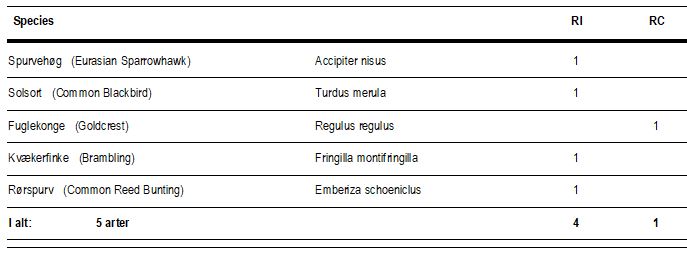Gedser Fuglestation Blog
Her på Gedser Fuglestations blog bringes korte nyheder i dagbogsformat om hændelser på fuglestationen.
Close your Mouth and Open your Eyes
Ringmærkningen: Det har været en vild dag – ikke så meget på grund af fuglene, men vinden var ret vild, så vi måtte lade en hel del af nettene være lukkede.
Vi måtte stille os til takke med 4 ringmærkede fugle. Dertil en enkelt aflæsning af en gammel kending i haven. Den aflæste Fuglekonge blev nemlig ringmærket den 25. oktober og er siden blevet aflæst 4 gange.
Første runde bød på denne unge (1K) Kvækerfinke han. Foto: Susanne Primdahl
Senere på formiddagen fik Larissa lejlighed til at ringmærke sin anden Spurvehøg. Denne gang var det en 2K han fra sidste år. Foto: Susanne Primdahl
Dagens ringmærkede (RI) og aflæste (RC) fugle:
Migration at Gedser Odde
by Lara W
3,193 individuals of 38 species were counted on migration today. A steady flow of Common Eider/Ederfugl (Somateria mollissima) passed throughout standard time this morning, with 1,393 counted. 580 of these were identified as Female/Juvenile/Hun-farvet, compared to 285 Males, a much better ratio considering the male-dominated migration up until recently. Red-breasted Merganser/ Toppet Skallesluger (Mergus serrator) came by in much higher numbers than previously, totalling 344 migrating south, mostly in groups of 3-4 but occasionally in larger flocks of up to 16. Their flight pattern is patently recognisable – the long neck and rapidly-fluttering wings with their obvious white wing bar making identification easy. I was happy to spot a single Goosander/Stor Skallesluger (Mergus merganser), a cousin to the Red-breasted Merganser, later on in the morning, with its pale creamy-yellow neck and strongly demarcated dark head. A very smart bird!
Goldeneye/Hvinand and Long-tailed Duck/Havlit are gradually becoming more numerous, with 63 and 11 counted respectively. 37 Red-throated Diver/Rødstrubet Lom were spotted too, often flying past in twos and threes. Observing this genus fly always affords me an internal chuckle (alright, a slightly mean-spirited snigger, I will admit): on the water, divers are stunningly elegant, their sinuous and slender necks poised in an attitude of permanent grace, their plumage perfectly coiffed. In the air, however, they morph into hump-backed, awkward-looking, ill-proportioned, and simply weird-in-general creatures. There is a balance in most things is the moral here, it seems.
Many birds came close to shore as they passed south today, in numbers that enabled me to view them properly, allowing appreciation for the many forms, and colours, and movement, that the long process of evolution has created. Number- and rarity-chasing are hobbies for some, but sometimes it is just as special to sit and watch nature as it is: fluid, vivid, transient, built to stand the test of time and the pressures of the world through the constant and consistent transmogrification from one form to another. Our presence, as a species, on this planet, is a miracle in itself, despite the negative effects we have on the environment, but one thing is for sure: nothing we do will stop nature. It will continue on without us when we are long gone, all we can do now is appreciate it in all its splendour, and try to protect it.
Take a breath, pause, and look out the window. What can you see that does not demand admiration? We are surrounded by beauty, you really don’t have to look far to see it.
People at the station: Lara Winsloe, Larissa Britton, Ole Friis Larsen, Anne Hermanns, Susanne Primdahl, Henrik Jørgensen





